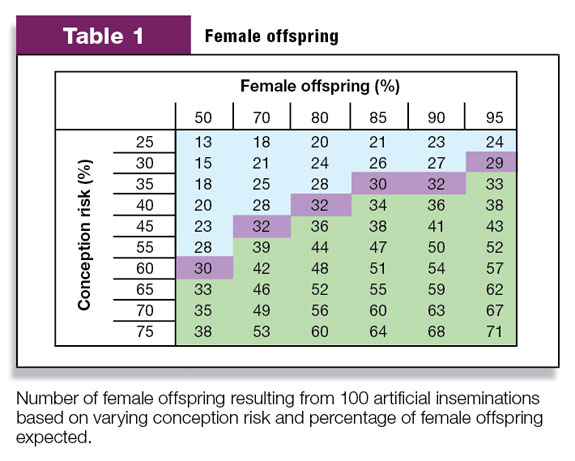The sex sorting of semen is a relatively new technology that has been commercially available to U.S. dairy producers since early 2006. The process of sorting semen by gender was developed in the late 1980s and has improved significantly over time. Today, most sexed semen is sorted so that 85 to 90 percent of the offspring are of the desired gender.
For dairy, sexed semen technology increases the chance of a heifer calf from about 50 percent with conventional semen to nearly 90 percent when sexed semen is used. Increasing the number of heifer calves born on the dairy allows a producer to rapidly expand the herd from within.
Since heifer calves tend to be smaller than bull calves, their delivery is usually easier. Thus, another benefit is fewer calving problems (dystocia).
Besides the increased cost of sexed semen, decreased conception risk (CR) prevents some producers from adopting this technology. Conception risk declines 12 to 20 percent compared to conventional semen. Because of this undesirable feature, sexed semen has been primarily used and is only recommend for virgin heifers.
Producers must evaluate the economics of using sexed semen based on their herd information. To simplify comparisons, assume all insemination costs except the price of sexed or conventional semen remain the same.
First, determine the current CR and what percent of heifer calves is desired. Once this information is known, the next step is to calculate how low the CR for sexed semen can be without compromising the number of heifers born.
Typically this information can be obtained from a dairy management software program. For example, on DairyComp 305, the command BREDSUM\CY retrieves the CR for virgin heifers. The command EVENTS FOR LACT=1\3 provides the percentage of heifers born.

With this information, you can then use Table 1 to estimate how low CR can be without decreasing the number of heifers born if sexed semen technology is adopted.
For example, if the average CR (rows on Table 1) for virgin heifers is 60 percent with 50 percent female offspring (columns on Table 1), every 100 inseminations are expected to yield 30 female offspring.
If sexed semen results in 85 percent female offspring, the lowest CR required to yield 30 females is 35 percent (Table 1).
If you decide to adopt sexed semen for virgin heifers, some tips to maximize the CR include:
- Use the appropriate breeding gun for the straw size.
- Thaw straws according to supplier’s directions, typically in a 95°F water bath for 45 seconds.
- Provide warm, draft-free semen thawing and handling environments.
- Warm all semen-handling materials such as guns and sheaths prior to contacting straws.
- Assign only experienced technicians to breed with this product.
- Use only on heifers that are over 60 percent of their mature weight by 14 months of age that are in good BCS.
- Inseminate heifers 8 to 12 hours after observed estrus (AM/PM Rule).
- Breed based on observed estrus rather than at a timed insemination for best results. PD
This article is part of the TDM fact sheet series (July 2011) and can also be viewed at http://texasdairymatters.org
—Excerpts from Dairy Team – Texas A&M System Vol. 7 – Fall 2011

-
Ralph Bruno
- Livestock Texas AgriLife Extension Servicer
- Email Ralph Bruno






